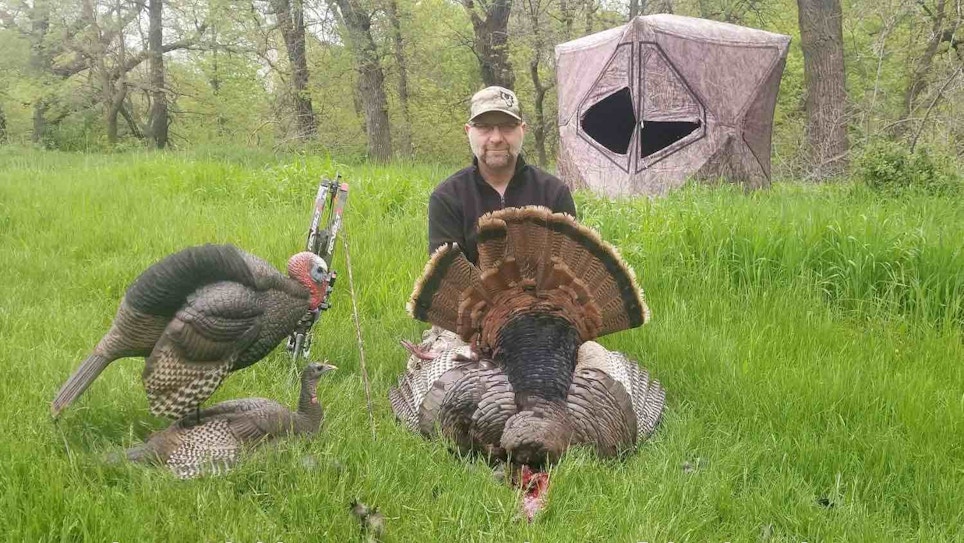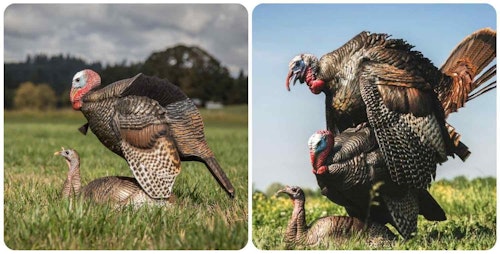
The author sat with one of his hunting buddies, Scott (above), during a late-season turkey hunt in South Dakota. This tom was tagged during midday, when many hunters have typically left the woods.
Many turkey hunters pursue birds early and late in the day, leaving the woods for lunch and a midday nap. While it’s easy to understand why, these hunters are actually skipping the top two or three hours.
For example, consider this recent Memorial Day weekend turkey hunt in South Dakota. I’d already killed a gobbler with my bow, but one of my buddies, Scott, still had an open archery tag, so I joined him.
Sunrise is early during late season. We had a 20-minute drive to our hunting property, so we set our alarms for 4 a.m. in order to be on the road by 4:30 a.m. A 10-minute hike to a pop-up blind, which was already in place, ensured we’d be hidden and quiet by 5 a.m., before birds could see us hiking and placing decoys. We didn’t expect any birds to fly down from the roost until at least 5:15 a.m.
Gobbling from the roost was minimal, which is common during late season; we heard only a couple birds far in the distance. As the hours ticked by, we saw one hen, and fought off sleep. Five hours later, we finally heard a tom gobble about 100 yards south of our blind. At least three times the gobbler answered our hen yelps from a slate call, but after waiting a half-hour, we concluded the bird hadn’t moved.
I convinced Scott to try sneaking on the anchored turkey, something we avoid earlier in the season when there’s less leaf growth and birds are traveling in larger groups. Scott eventually spotted the strutting bird, but it moved off before he could sneak in for a shot. He was back in the blind by 10:30 a.m.
At 10:45 a.m. we heard a turkey gobble twice about 200 yards north. The tom wouldn’t answer Scott’s slate call, so we waited — and hoped. By 11:30 a.m., again our heads were bobbing, craving sleep.
“Let’s call it,” Scott said. “Lunch and a nap sound pretty good right now.”
“Let me try my box call first,” I said. “Maybe the tom couldn’t hear your slate in the wind.”
I hammered out several ear-busting yelps on the box, waited 15 seconds, then repeated the sequence. No gobbles.
“Five minutes and we’re gone,” I suggested.
So tired that it hurt, we scanned our surroundings through drooping eyelids.
“Turkeys coming down the hill to the east!” I whisper-shouted to Scott.
A glimpse through my bino revealed two toms slowly descending into our river-bottom from the right (east). One of the birds probably made the gobbles we heard 50 minutes ago.
The birds slowly rounded a bend in the two-track and then Scott pulled the cord to add movement to his Dave Smith Decoys Mating Motion Pair, which consists of a Mating Jake over the top of a Mating Hen. These fakes were placed only 6 yards from our blind, with a DSD Upright Hen at 12 yards. Our three-decoy spread must have looked appealing because both toms slowly but steadily walked our direction.
There was no reason to call again. In our experience, it’s common for a lone tom to lose interest before reaching the decoys, but that’s not the case with two toms. There’s something about the competition between two toms; neither one wants to be left behind and out of the action.
Scott drew his bow when the pair were 10 yards from the jake decoy, and waited for them to appear in front of our opened window. He could keep an eye on their progress through a small mesh-covered side window.
The lead tom didn’t pause as birds often do when finally reaching a jake decoy. Instead, the tom immediately jumped on top the jake decoy and hit it with his wings, causing it to fall on its side. The tom regained his balance and again climbed on the decoy, which was laying on its side. Having trouble balancing on the fake, the tom stretched out his wings, and his neck, giving Scott a perfect head-on shot with his Magnus Bullhead broadhead.
A split-second later — at 11:40 a.m. — our hunt was over. Lesson learned? Midday is often the best time to tag a turkey.

Lunchtime Gobblers
I’ll never miss a sunrise hunt because I love the sound of toms firing from the roost at everything from coyotes and owls to crows and ducks. Yes, my buddies and I have experienced success before the sun peaked above the eastern horizon, but more often than not, toms quickly meet up with hens roosted nearby, then those hens lead the toms in some direction other than passed our ambush. In eastern South Dakota, the birds typically leave the wooded river-bottoms and travel to nearby picked agricultural fields to scavenge for leftover corn.
Toms and hens will feed together until hens leave to lay eggs or sit on a nest. After the hens disappear, the toms will often switch into search mode — and unfortunately, most hunters have already left the field and headed back to camp for lunch and a nap.
The lonely toms don’t search picked crop fields for hens during midday; they can see that the hens have left. Instead, toms move back into the forested river-bottoms and adjacent meadows/pastures — exactly where you were hunting in the morning before leaving for lunch.
If you must take a nap, then do so in the blind (or nearby it) and set your phone alarm for 10 a.m. Get back to calling and watching, and have confidence that toms are on the move searching for a willing hen. Hunt hard from approximately 10 a.m. to 1 p.m. Pack a lunch and eat during that period, too. If you absolutely must exit the woods for some reason, try to do so after 1 p.m. (Tip: A hammock tied between two big trees works well for sleeping and avoiding ticks.)
What about late-in-the-day pursuits? Turkey hunting the couple hours prior to sunset near roosting trees is risky on a small property because the chance of messing up your following morning hunt is high. If you have the luxury of hunting several properties, however, then you can hunt late in the day on one property and save another one for morning and midday ambushes.
Many hunters are programmed through their whitetail pursuits to believe that morning and evening hunts are best, and midday is typically a waste of time. Tom turkeys are actually similar to a rutting whitetail buck that cruises for companionship during midday. Remember this the next time you plan your daily turkey game plan.








